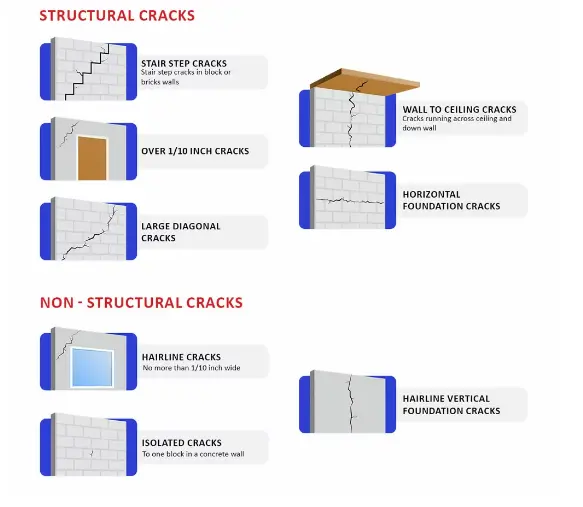Cracks in walls and ceilings can be a common sight in many homes and buildings. While some of these cracks are purely cosmetic, others could be warning signs of more serious structural problems. Understanding cracks in walls and ceilings when to worry is crucial for homeowners to ensure their property’s safety and longevity. In this article, we’ll explore the causes of these cracks, how to identify potential problems, and when to seek professional help.
Understanding Cracks in Walls and Ceilings
When you notice cracks in walls and ceilings, it’s essential to assess their type, size, and location. Not all cracks are the same, and understanding their characteristics can provide insight into whether they’re harmless or serious. Cracks can occur in plaster, drywall, or even within the structural elements of your home.
Structural vs. Non-Structural Cracks

Cracks in walls and ceilings are categorized as structural or non-structural.
- Non-Structural Cracks: These are typically surface-level issues that occur due to material wear, temperature changes, or minor settling. They don’t affect the building’s integrity.
- Structural Cracks: These are more concerning, as they indicate problems with the foundation, support beams, or other load-bearing components.
Let’s take a closer look at some common types of cracks and their potential causes.
Types of Cracks in Ceilings and Walls
Here are some types of wall and ceiling cracks:
1. Hairline Cracks
Hairline cracks are thin and often superficial. They are common in new homes or those that have recently undergone renovations. These cracks usually form as the building settles and adjusts to environmental factors. Hairline cracks are generally nothing to worry about, but if they continue to grow or reappear after repair, they might indicate deeper issues.
2. Vertical and Diagonal Cracks
Vertical and diagonal cracks often result from normal settling or soil movement. However, if these cracks are accompanied by doors or windows that stick, uneven floors, or gaps between walls and ceilings, they could signal significant foundation movement. Such issues require immediate attention to prevent further structural damage.
3. Horizontal Cracks
Horizontal cracks are more alarming, especially if they appear in basement walls. These cracks may indicate structural stress caused by soil pressure, hydrostatic pressure, or a shifting foundation. Horizontal cracks can compromise the safety of your home, making professional evaluation essential.
4. Stair-Step Cracks
Stair-step cracks are usually found in brick or block walls and resemble a staircase pattern. These cracks are typically caused by uneven foundation settling, poor drainage, or soil erosion. Left unaddressed, stair-step cracks can lead to severe structural problems.
Cracks in Walls and Ceilings When to Worry
The critical question for many homeowners is, “How do I know when cracks in walls and ceilings are serious?” There are several indicators that can help you determine whether you should be concerned.
Signs to Watch For
- Crack Size
- Cracks wider than 1/8 inch or those that continue to grow are more likely to indicate structural issues.
- Crack Location
- Cracks near doors, windows, or where walls meet ceilings can signal foundation settling or structural instability.
- Direction of Cracks
- Horizontal or diagonal cracks often indicate more severe problems than vertical ones.
- Additional Symptoms
- Accompanying signs such as sagging ceilings, uneven floors, or water stains can signal deeper issues.
By understanding cracks in walls and ceilings when to worry, you can take timely action to prevent minor problems from escalating into major repairs.
What Causes Cracks in Walls and Ceilings?
Understanding the root causes of cracks in walls and ceilings can help determine whether they require professional intervention. Here are some of the most common reasons:
1. Settling and Shifting
As houses age, they naturally settle into the ground. This process can cause minor cracks in walls and ceilings. While small cracks are usually harmless, significant ones might indicate foundation settlement issues.
2. Thermal Expansion and Contraction
Temperature fluctuations cause building materials to expand and contract. Over time, this natural process can lead to cracks in plaster, drywall, or even structural elements.
3. Moisture Problems
Excessive moisture from leaks, flooding, or poor ventilation can weaken building materials, leading to cracks. Additionally, moisture issues may cause mold and mildew, creating health risks for occupants.
4. Poor Construction Practices
Substandard construction materials or improper techniques can lead to cracks in walls and ceilings. Ensuring high-quality materials and skilled workmanship during construction is essential to prevent these issues.
5. Environmental Factors
Soil movement, earthquakes, and extreme weather conditions can all contribute to cracking. For instance, heavy rainfall or drought can cause soil to shift, affecting the foundation and leading to cracks.
When to Worry About Cracks in Walls and Ceilings
While some cracks are harmless, others require immediate attention. Here’s how to assess cracks in walls and ceilings when to worry:
Cracks That Need Immediate Attention
- Horizontal Cracks in Basement Walls
- These often indicate high soil pressure or foundation problems and can compromise the home’s stability.
- Cracks Wider at the Top
- If cracks are wider at one end, it may indicate shifting or settling issues that need professional evaluation.
- Cracks with Sagging Ceilings or Floors
- Sagging is a significant concern that could indicate compromised structural integrity.
- Cracks Accompanied by Water Damage
- Water-stained cracks suggest leaks or poor drainage, which can weaken the structure over time.
- Reappearing Cracks After Repair
- If cracks reappear after being filled, it could indicate an unresolved structural issue.
How to Manage Cracks in Walls and Ceilings
1. Regular Inspections
Inspect your home regularly for new cracks or changes to existing ones, especially after extreme weather events. Early detection is key to preventing more serious issues.
2. Cosmetic Repairs
For minor cracks, simple repairs using spackle or plaster can be sufficient. Ensure the area is clean and dry before applying filler, and repaint to restore the surface.
3. Professional Evaluation
For larger or more concerning cracks, hire a licensed structural engineer or foundation repair contractor. They can assess the severity of the problem and recommend appropriate solutions.
4. Preventive Measures
- Address moisture issues promptly to prevent water damage.
- Ensure proper drainage around your home to reduce soil movement.
- Use high-quality materials during construction and renovations.
Why Addressing Cracks is Important
Ignoring cracks in walls and ceilings can lead to costly repairs or even safety hazards. Knowing cracks in walls and ceilings when to worry allows homeowners to act proactively, ensuring their property remains secure and stable.
Key Takeaways
- Hairline cracks are usually harmless but should be monitored for progression.
- Horizontal cracks or those in stair-step patterns often indicate serious structural problems.
- Accompanying signs like sagging ceilings or sticking doors suggest deeper issues.
By addressing cracks early and consulting professionals when necessary, you can protect your home from significant damage.
Professional Help for Cracks in Walls and Ceilings
If you’re uncertain about the severity of a crack, it’s always better to be cautious. At AMC911, we specialize in identifying and repairing structural issues related to cracks in walls and ceilings. With over 30 years of experience, we have the expertise to assess the problem and provide long-lasting solutions.
Don’t let cracks compromise your home’s safety. Contact us today to learn more about how we can help you address cracks in walls and ceilings when to worry and keep your property secure. To read more guiding articles, please check UK-Home Improvement daily basis.


High humidity can indeed cause significant damage to plaster over time. To prevent moisture-related cracks, consider using a dehumidifier, improving ventilation with exhaust fans, and applying moisture-resistant paint or sealants. Regularly inspecting for leaks and addressing them promptly can also help maintain the integrity of the plaster. Let me know if you need further advice!